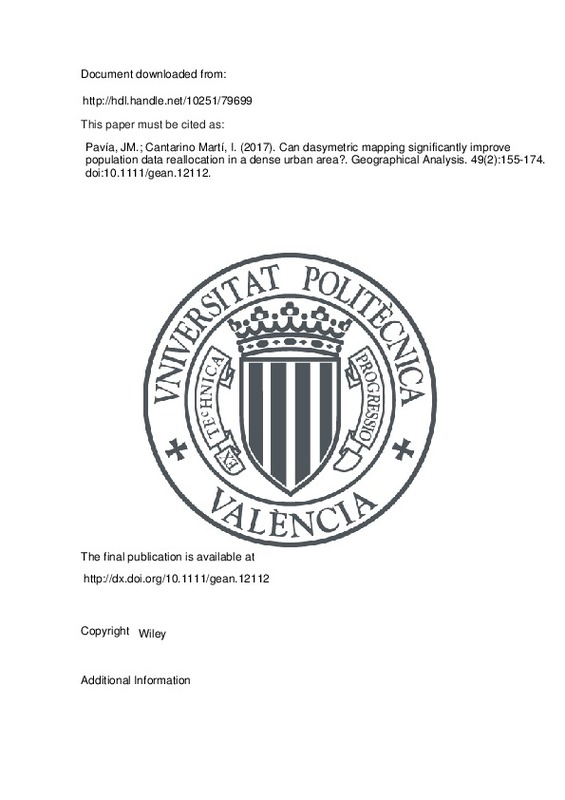JavaScript is disabled for your browser. Some features of this site may not work without it.
Buscar en RiuNet
Listar
Mi cuenta
Estadísticas
Ayuda RiuNet
Admin. UPV
Can dasymetric mapping significantly improve population data reallocation in a dense urban area?
Mostrar el registro sencillo del ítem
Ficheros en el ítem
| dc.contributor.author | Pavía, José M.
|
es_ES |
| dc.contributor.author | Cantarino Martí, Isidro
|
es_ES |
| dc.date.accessioned | 2017-04-12T14:20:12Z | |
| dc.date.available | 2017-04-12T14:20:12Z | |
| dc.date.issued | 2017-04 | |
| dc.identifier.issn | 0016-7363 | |
| dc.identifier.uri | http://hdl.handle.net/10251/79699 | |
| dc.description.abstract | The issue of reallocating population figures from a set of geographical units onto another set of units has received a great deal of attention in the literature. Every other day, a new algorithm is proposed, claiming that it outperforms competitor procedures. Unfortunately, when the new (usually more complex) methods are applied to a new data set, the improvements attained are sometimes just marginal. The relationship cost-effectiveness of the solutions is case-dependent. The majority of studies have focused on large areas with heterogeneous population density distributions. The general conclusion is that as a rule more sophisticated methods are worth the effort. It could be argued, however, that when we work with a variable that varies gradually in relatively homogeneous small units, simple areal weighting methods could be sufficient and that ancillary variables would produce marginal improvements. For the case of reallocating census data, our study shows that, even under the above conditions, the most sophisticated approaches clearly yield the better results. After testing fourteen methods in Barcelona (Spain), the best results are attained using as ancillary variable the total dwelling area in each residential building. Our study shows the 3-D methods as generating the better outcomes followed by multiclass 2-D procedures, binary 2-D approaches and areal weighting and 1-D algorithms. The point-based interpolation procedures are by far the ones producing the worst estimates. | es_ES |
| dc.description.sponsorship | We wish to thank three anonymous referees for their valuable suggestions and comments, the Spanish Official Statistical Agency (INE) for their first-rate assistance in producing, from individual records, the benchmark variables analyzed in this research and Marie Hodkinson for revising the English of the paper. This work was supported by the Spanish Ministry of Economics and Competitiveness under Grant CSO2013-43054-R. | en_EN |
| dc.language | Inglés | es_ES |
| dc.publisher | Wiley | es_ES |
| dc.relation.ispartof | Geographical Analysis | es_ES |
| dc.rights | Reserva de todos los derechos | es_ES |
| dc.subject | Dasymetric mapping | es_ES |
| dc.subject | Population data reallocation | es_ES |
| dc.subject | Census data | es_ES |
| dc.subject.classification | INGENIERIA DEL TERRENO | es_ES |
| dc.title | Can dasymetric mapping significantly improve population data reallocation in a dense urban area? | es_ES |
| dc.type | Artículo | es_ES |
| dc.identifier.doi | 10.1111/gean.12112 | |
| dc.relation.projectID | info:eu-repo/grantAgreement/MINECO//CSO2013-43054-R/ES/ESTRUCTURA SOCIAL, ENCUESTAS Y ELECCIONES/ | es_ES |
| dc.rights.accessRights | Abierto | es_ES |
| dc.contributor.affiliation | Universitat Politècnica de València. Escuela Técnica Superior de Ingeniería Geodésica, Cartográfica y Topográfica - Escola Tècnica Superior d'Enginyeria Geodèsica, Cartogràfica i Topogràfica | es_ES |
| dc.description.bibliographicCitation | Pavía, JM.; Cantarino Martí, I. (2017). Can dasymetric mapping significantly improve population data reallocation in a dense urban area?. Geographical Analysis. 49(2):155-174. https://doi.org/10.1111/gean.12112 | es_ES |
| dc.description.accrualMethod | S | es_ES |
| dc.relation.publisherversion | http://dx.doi.org/10.1111/gean.12112 | es_ES |
| dc.description.upvformatpinicio | 155 | es_ES |
| dc.description.upvformatpfin | 174 | es_ES |
| dc.type.version | info:eu-repo/semantics/publishedVersion | es_ES |
| dc.description.volume | 49 | es_ES |
| dc.description.issue | 2 | es_ES |
| dc.relation.senia | 317746 | es_ES |
| dc.identifier.eissn | 1538-4632 | |
| dc.contributor.funder | Ministerio de Economía y Competitividad | es_ES |
| dc.contributor.funder | Instituto Nacional de Estadística | es_ES |







![[Cerrado]](/themes/UPV/images/candado.png)

